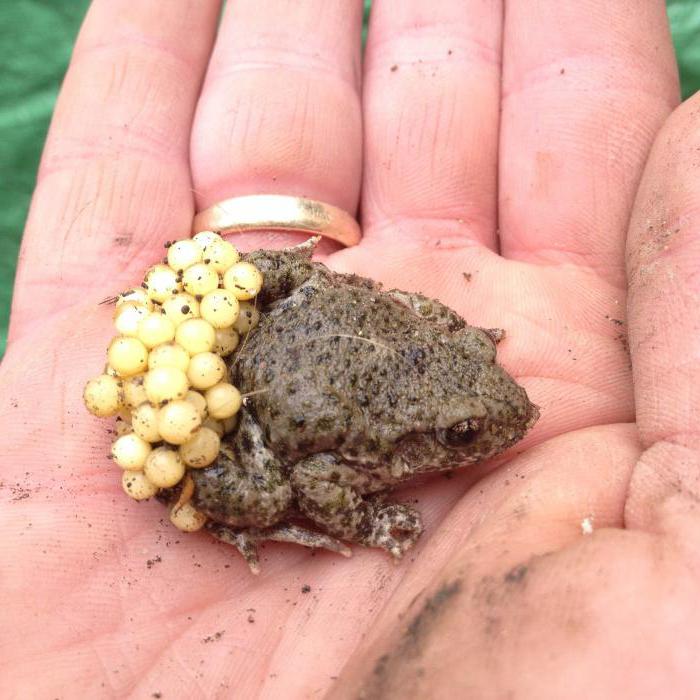Many of us do not like toads, because they have a repulsive appearance and it is unpleasant to pick them up. And it is unlikely that anyone would dare to do this, except for lovers of these amphibians. But in vain. Representatives of this species have something to surprise a person. Among them are many unusual and interesting individuals. These include the midwife toad.
Appearance
Outwardly, she looks like her relatives. Although, of course, it has individual characteristics that make it possible to distinguish it from other toads. Like all members of this family, her skin is dry and warty. Its color is ash gray with olive spots. The midwife toad has a small head with large eyes, with closing eyelids. In length, these animals reach 5.5 centimeters. These animals have eardrums and hear well. Colors and smells are also distinguished. Warts on the body of a toad are not just located. These are glands that secrete toxic mucus at the time of danger. If someone tries to eat it, it will certainly recover. Sometimes such daredevils from the animal world even perish.
Where does he live and what does he eat
Its habitat is land. It prefers a mountainous surface, which allows this creature to hide under the stones during daylight hours. Also, this amphibian can bury itself in the soil or take refuge in a mink or pit. Still these toads settle near the rivers and lakes with clear water. You can meet them in the forest. They are usually found in Western Europe, Germany, France, Luxembourg, the Netherlands, Great Britain, Belgium, Switzerland. These amphibians feed on worms, slugs, flies, caterpillars, spiders, wood lice. They hunt them at night, sitting motionless and waiting for their prey. From October to March, this amphibian hibernates.
Toads are different
There are several species of these amphibians. For example, in central Spain, southern and eastern Portugal, an Iberian midwife toad lives. It has a brownish back with dark spots and a dirty white abdomen. Able and likes to dig holes. The provincial midwife has a whitish or grayish color with dark spots. He prefers to live in ponds, ponds, marshes, on pastures, in forests. It is considered a rare species and is protected in regional territories.
It’s not often that you meet a Balearic midwife toad. Scientists have proven that its habitat is gradually declining. Currently, this species lives in the mountainous part of about. Mallorca, where it is always dry and hot. This small amphibian is only 3.5-3.8 centimeters long, has smooth skin, dark green or golden yellow color, and also a black triangle on the occipital part of the head. Her body is flattened, thanks to this the Balearic toad penetrates the narrow cracks between the stones in the caves where she lives. It differs from other midwives in that reproduction does not take place on land, but in puddles left after rain.
Why is it so called
Of particular note is the reproduction of the midwife toad. After all, it is precisely the way with which it occurs that it owes its name. To mate with a female, the male makes melodic sounds sitting in his mink. This gentle singing attracts the lady and she comes close to the house in which the gentleman awaits her. Without wasting time, the male climbs onto the female’s back, grabs her body with the front legs, and inserts the hind legs between her hind limbs. In this position, it is convenient for him to immediately fertilize the eggs after the female has laid them. Usually its masonry is two ribbons containing 20-60 eggs. After mating, the male, using the hind legs, winds these cords onto his hips. He does not stop there, but continues the search. Mating takes place on land. Having fertilized in this way, another 2-3 females, he continues to lead a normal lifestyle.
Offspring Care
The male takes care that nothing bad happens with caviar. He wears it on himself, periodically moisturizing in a pond. If scared, he may lose his spawn or lose it while moving. But nature itself made sure that the masonry was intact throughout the incubation period. The toad eggs are covered with a dense shell that protects them from drying out. Even in lost eggs, development continues. After 3-4 weeks, the midwife toad, the photo of which is presented in this article, goes to the reservoir. There she swims actively so that all the tadpoles hatch, and then removes the tapes from her body and returns to land. Since the reproduction of these amphibians does not depend on any season, and mating can occur in any of them, it may turn out that the larvae do not have time to turn into an adult before spring. Then they dig in the silt and winter at the bottom of the reservoir. Interestingly, at the stage of the tadpole, the midwife can spend a rather long time until favorable conditions for transformation occur, for example, an increase in water temperature.

This is how this amphibian spends his life. Very unusual looks with caviar on the paws of a midwife toad. Interesting facts, collected at different times, suggest that these creatures came to England due to the fact that they were accidentally brought there along with plants. In the Pyrenees mountains they live at an altitude of 1.5-2 thousand meters. From other amphibians they are distinguished by a thick round tongue. So do not disdain toads midwives. They are very interesting animals and know how to take care of their offspring like no other.